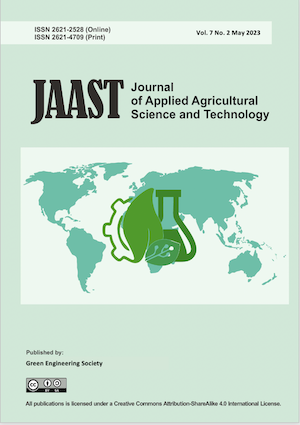Production of Canarium (Canarium indicum L) Butter with Different Sugar Concentrations
##plugins.themes.academic_pro.article.main##
Abstract
Tree nuts and groundnuts nowadays are gaining popularity due to their health benefits. Nut kernels that can be eaten raw or roasted are becoming increasingly popular in healthy diet, including canarium nut. Therefore, it should be used into a variety of food compositions, including butter, to promote a healthy diet and lifestyle. The objective of the research was to determine the exact sugar concentration in the production of canarium nut butter. A completely randomized experimental design with four levels of sugar concentrations i.e. 0%, 20%, 40%, and 60% was applied in this research. Chemical and sensory properties were analysed. Results showed that the sugar concentration of 40% was the exact concentration for producing canarium nut butter. The canarium nut butter at 40% sugar concentration had a moisture content of 17.70%, an ash content of 2.68%, a protein content of 6.19%, a fat content of 32.69%, and a reducing sugar content of 25.31%. Canarium nut butter at 40% sugar was also more liked on taste, texture, and its overall likeness; it was only slightly liked on aroma. This butter was rated as sweet, having a nutty aroma, smooth, and very easy to spread.
##plugins.themes.academic_pro.article.details##

This work is licensed under a Creative Commons Attribution-ShareAlike 4.0 International License.
References
- Abegaz, E. G., Kerr, W. L., & Koehler, P. E. (2006). Descriptive Sensory Analysis of Stored Model Peanut Confections with Different Sugar, Moisture, and Antioxidant Levels. Peanut Science, 33(1), 53–59. https://doi.org/10.3146/0095-3679(2006)33[53:dsaosm]2.0.co;2
- Alamsyah, M. F. (2015). Formulasi Daya Terima dan Kandungan Gizi Selai Kacang Galohgor [Institut Pertanian Bogor] (Thesis). Retrieved from https://repository.ipb.ac.id/handle/123456789/75104
- AOAC. (2019). Official Methods Of Analysis Book (21st Edition). Association Of Official Anaylitical Chemist. Inc. https://www.aoac.org/official-methods-of-analysis-21st-edition-2019/
- Arsyad, M. (2018). Pengaruh Konsentrasi Gula Dalam Pembuatan Selai Kelapa Muda (Cocos nucifera L). Gorontalo Agriculture Technology Journal, 1(2), 35–45. https://doi.org/https://doi.org/10.32662/gatj.v1i2.424
- Ashaye, O. A., & Adeleke, T. O. (2009). Quality Attribute of Stored Rosella Jam. International Food Research Journal, 16, 363–371. http://ifrj.upm.edu.my/16 (3) 2009/9[1] Ashaye.pdf
- Asmawatri, Sunardi, H., & Ihromi, S. (2018). Kajian Penambahan Gula Terhadap Komponen Mutu Sirup Buah Naga Merah. Jurnal Agrotek, 5(2), 1–10. https://doi.org/https://doi.org/10.31764/agrotek.v5i2.700
- Bai, S. H., Brooks, P., Gama, R., Nevenimo, T., Hannet, G., Hannet, D., Randall, B., Walton, D., Grant, E., & Wallace, H. M. (2019). Nutritional quality of almond, canarium, cashew and pistachio and their oil photooxidative stability. Journal of Food Science and Technology, 56(2), 792–798. https://doi.org/10.1007/s13197-018-3539-6
- Chang, A. S., Sreedharan, A., & Schneider, K. R. (2013). Peanut and peanut products: A food safety perspective. Food Control, 32(1), 296–303. https://doi.org/10.1016/j.foodcont.2012.12.007
- Di Monaco, R., Miele, N. A., Cabisidan, E. K., & Cavella, S. (2018). Strategies to reduce sugars in food. Current Opinion in Food Science, 19, 92–97. https://doi.org/10.1016/j.cofs.2018.03.008
- Djarkasi, G. S. S., Lalujan, L., Nurali, E. J. N., Tuju, T. J. D., Rawung, D., & Sumual, M. F. (2017). Chemical Composition and Antioxidant Properties of Kenari (Canarium indicum) Nut. The Pharmaceutical and Chemical Journal, 4(4), 79–84. http://tpcj.org/download/vol-4-iss-4-2017/TPCJ2017-04-04-79-84.pdf
- Ellen, R. (2019). Ritual, Landscapes of Exchange, and the Domestication of Canarium: A Seram Case Study. Asian Perspectives, 58(2), 261–286. https://doi.org/10.1353/asi.2019.0016
- Figuerola, F. E. (2007). Berry Jams and Jellies. Boca Raton, Florida, USA: CRC Press.
- Fitantri, A. L., Parnanto, N. H. R., & Praseptiangga, D. (2014). Kajian Karakteristik Fisikokimia dan Sensoris Fruit Leather Nangka (Artocarpus heterophyllus) Dengan Penambahan Karaginan. Jurnal Teknosains Pangan, 3(1), 26–34. https://jurnal.uns.ac.id/teknosains-pangan/article/view/4598
- Goldfein, K. R., & Slavin, J. L. (2015). Why Sugar Is Added to Food: Food Science 101. Comprehensive Reviews in Food Science and Food Safety, 14(5), 644–656. https://doi.org/10.1111/1541-4337.12151
- Gorrepati, K., Balasubramanian, S., & Chandra, P. (2015). Plant based butters. Journal of Food Science and Technology, 52(7), 3965–3976. https://doi.org/10.1007/s13197-014-1572-7
- Jaldin, A., Haslianti, & Asyik, N. (2019). Pengaruh Perbandingan Konsentrasi Glukosa dan Sukrosa Terhadap Kualitas Sensori dan Kimia Permen Jelly Rumput Laut (Euchuma cotonii). Jurnal Fish Protech, 2(2), 234–243. http://dx.doi.org/10.33772/jfp.v2i2.9474
- Kusuma, T. S., Kusnadi, S., & Winarsih. (2017). Kombinasi Pasteurisasi, Suhu, dan Lama Penyimpanan Terhadap Kadar Aflatoksin Pada Selai Kacang Tanah. Indonesian Journal of Human Nutrition, 4(2), 88–96. https://doi.org/10.21776/ub.ijhn.2017.004.02.3
- Laddha, A. P., Adki, K. M., Gaikwad, A. B., & Kulkarni, Y. A. (2020). Beneficial Effects of Nuts From India in Cardiovascular Disorders. San Diego, CA, USA. Elsevier Inc. https://doi.org/10.1016/B978-0-12-818553-7.00032-2
- Mailoa, M., Widyaningsih, T. D., Putri, W. D. R., & Harijono. (2019). Fresh and roasted Canarium nut (Canarium vulgare) altering the lipid profile of hypercholesterolemic rats (Rattus norvegicus). Eurasia J Biosci, 13, 231–238. https://www.proquest.com/docview/2234975066?pq-origsite=gscholar&fromopenview=true
- Millena, C. G., & Sagum, R. S. (2018). Physicochemical Characterization and Fatty Acid Profiling of Different Philippine Pili Nut (Canarium ovatum, Engl.) Varieties. JAOCS, Journal of the American Oil Chemists’ Society, 95(3), 325–336. https://doi.org/10.1002/aocs.12028
- Mulindwa, J., Kaaya, N. A., Tumuhimbise, G., & Puppala, N. (2019). Production and Characterization of Nutritious Peanut Butter Enhanced With Orange Fleshed Sweet Potato. Novel Techniques In Nutrition and Food Science, 4(4), 356–366. https://doi.org/10.31031/NTNF.2019.04.000593
- Ozcan, M., & Seven, S. (2003). Physical and Chemical Analysis and Fatty Acid Composition of Peanut, Peanut Oil and Peanut Butter From COM and NC-7 Cultivars. Gracas Aceites, 54(1), 12–18. https://doi.org/10.3989/gya.2003.v54.i1.270
- SNI. 1992. Mentega Kacang. Nomor SNI 01-2979-1992. http://sispk.bsn.go.id/SNI/DetailSNI/3349
- Shahidi-Noghabi, M., Naji-Tabasi, S., & Sarraf, M. (2019). Effect of emulsifier on rheological, textural and microstructure properties of walnut butter. Journal of Food Measurement and Characterization, 13(1), 785–792. https://doi.org/10.1007/s11694-018-9991-1
- Shakerardekani, A., Karim, R., Ghazali, H. M., & Chin, N. L. (2013). Textural, rheological and sensory properties and oxidative stability of nut spreads-a review. International Journal of Molecular Sciences, 14(2), 4223–4241. https://doi.org/10.3390/ijms14024223
- Thompson, L. A. J., & Evans, B. (2016). Canarium indicum var indicum and C. harveyi (Canarium Nut). Specific Profiles for Pacific Island Agroforestry, 1, 1–19. https://www.doc-developpement-durable.org/file/Culture/Arbres-Bois-de-Rapport-Reforestation/FICHES_ARBRES/Arbres-non-classes/Canarium-canariumnut.pdf
- Walton, D. A., Randall, B. W., Poienou, M., Nevenimo, T., Moxon, J., & Wallace, H. M. (2017). Shelf Life of Tropical Canarium Nut Stored under Ambient Conditions. In Horticulturae 3(1), 1-10, https://doi.org/10.3390/horticulturae3010024
- Winarno, F. G. (2008). Ilmu Pangan dan Gizi. Jakarta, Indonesia: PT Gramedia Pustaka Utama

